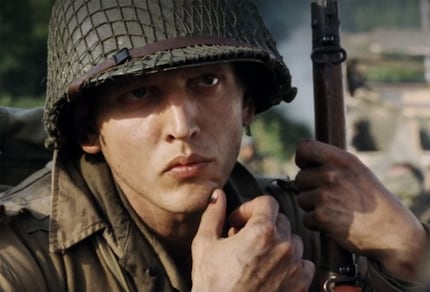
Background information
This rascal of a feature film is turning 50
by David Lee

Like all films, on-screen violence lives on attention to detail. "Saving Private Ryan is the perfect example. A look at blood, cruelty and a thumb.
Omaha Beach was a massacre. On 6 June 1944, 1,465 Americans perished as they disembarked from ferries directly into the machine-gun range of the Germans occupying France. The toll was heavy: in addition to the dead, there were 3,184 wounded, 1,928 missing and 26 prisoners. While the infantrymen survived the stormy seas - sometimes only because they had cleared the water from the landing pontoons with their helmets - they had to admit that the prior bombardment of the beach positions had been to no avail.
.
However, the operation was a success for the Allies. The 43,250 Allied infantrymen secured the beach and in so doing created a base for land operations on the European continent.
The Allies were not to be denied.
These scenes determined the first few minutes of the Hollywood film "Saving Private Ryan", "Il faut sauver le soldat Ryan" in French. They showed the love of detail shown by the stage managers, set designers, actors and scriptwriters. Where "Lord of the Rings" focuses on beauty, Private Rayan accentuates ugliness, blood and violence. The film is striking and remains impressive 20 years after its broadcast and 74 years after the Battle of Omaha Beach.
It's time to highlight some of these details.
As the troops around John H. Miller (Tom Hanks), who commands a company of Rangers, land on the beach, they are caught in heavy fire. In the midst of the massacre, a medic wages a desperate battle to save the life of a long-lost man. A bullet hits him in the abdomen and pierces his bottle. First water pours out of the bottle, then blood.
It's these details - like the soldiers who can't swim because their equipment is too heavy - that make the film so good. The absence of a soundtrack leaves the viewer alone with their emotions.
Later in the film, Miller and his team - they've left Omaha Beach behind - search for Private James Ryan (Matt Damon). The latter is to be brought back to his family as the last survivor of four brothers. But here's the thing: no one really knows where Ryan is.
In a village Private Caparzo (Vin Diesel) meets a little girl who reminds him of his niece. He wants to take her to safety. An argument breaks out between the soldiers in Miller's company. Caparzo raises his hand and is wounded by a sniper.
The German sniper has a clear view of the entire group of Americans for a long time. He waits. The reason: he wants to know who's in charge. But after the first shot, the sniper knows that all the rifles on the ground are looking for him. So he tries to shoot the commander. That way, the soldiers will be without a leader and will first have to reorganise. Time he could use to flee or reposition.
This tactic is often used in war. During the Second World War, soldiers in the Pacific War did not wear rank insignia or medical crosses. Also, no one was saluted or addressed with "Sir" or "Captain" in case a sniper lurked nearby and picked his targets.
The German sniper firing on Caparzo is killed by an Allied sniper. Private Jackson (Barry Pepper) kills the German (Leo Stransky) with a deft shot through the scope. Jackson says a prayer and thus immortalises himself in the cinematic memory of our culture.

Throughout the film, the American's thumb shows a haematoma. Jackson is left-handed and so pulls the trigger with his left index finger. As his rifle is made for right-handed shooters, he had to either switch hands or reload with his non-dominant hand. In stressful situations, such as during the war, he soon made a mistake and got his thumb stuck in the breech of his rifle.
Also interesting: sniper Jackson's scope is set incorrectly. The cross is always at the bottom right of the target and Jackson corrects by eye.
These are just some of the details that make "Saving Private Ryan" a masterpiece of cinematic history. In the end, a good cinematic story lives on small details, things that we don't necessarily see, but that we perceive. Films live on a gourd, a little patience or a thumb, for example.
Journalist. Author. Hacker. A storyteller searching for boundaries, secrets and taboos – putting the world to paper. Not because I can but because I can’t not.
Interesting facts about products, behind-the-scenes looks at manufacturers and deep-dives on interesting people.
Show all